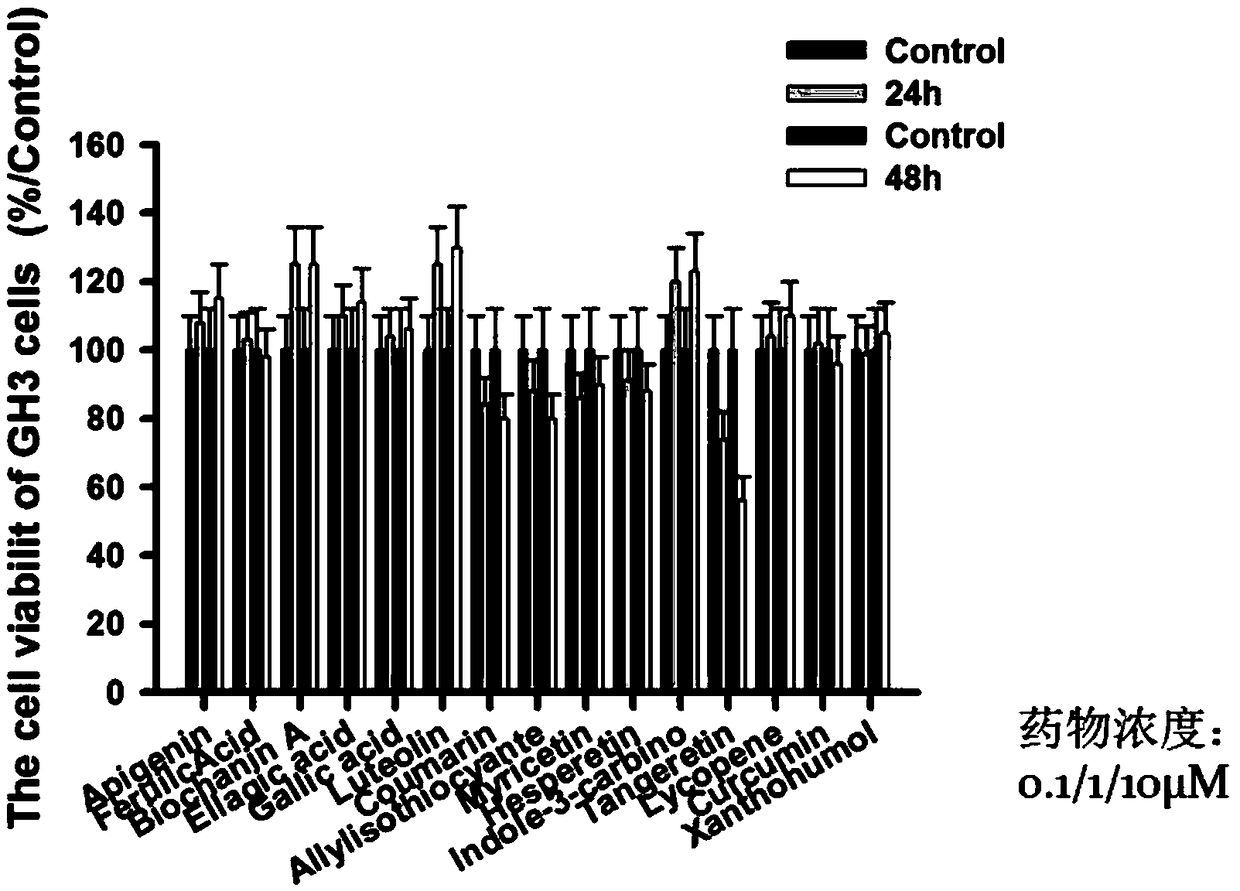Application of tangeretin in preparation of medicine for treating functional pituitary adenoma
A technology of pituitary adenoma and tangeretin, applied in the field of biomedicine, can solve the problems of side effects of dopamine agonists, patients taking long-term medication, and drug resistance
- Summary
- Abstract
- Description
- Claims
- Application Information
AI Technical Summary
Problems solved by technology
Method used
Image
Examples
Embodiment 1
[0026] The anti-tumor effects were compared among 35 kinds of extracts, and 15 kinds of compounds were selected for cytological experiments. Using different doses of drug concentrations in GH3 and MMQ cell lines, MTS experiments showed that 6 drugs had the effect of inhibiting cell proliferation, and the results were as follows Figure 1-Figure 4 As shown, there are 3 kinds of inhibitory effects on both cells, namely Allylisothiocyante (35% inhibition rate at 24 hours), Tangeretin (38.4% inhibition rate at 24 hours) and Xanthohumol (24% inhibition rate at 24 hours); there are 3 kinds Drugs can promote the proliferation of pituitary adenoma cells, among which Luteolin has the most obvious effect. Annexin V method was used to detect the occurrence level of apoptosis after drug treatment, and it was found that 1 μM Allylisothiocyante treatment for 24 hours: the apoptosis rate of GH3 cells was 16.4%, and the apoptosis rate of MMQ cells was 17.4%; 1 μM Tangeretin treatment for 24 h...
Embodiment 2
[0028] Tangeretin was configured as a 10mM stock solution with DMSO, and then diluted to different concentrations with DMSO when used. Prolactinoma MMQ cells were suspended and cultured in DEME medium (containing 2.5% fetal bovine serum, 12.5% horse serum, 1.176g / L sodium bicarbonate) in an incubator containing 5% carbon dioxide at 37°C After culturing for 48 hours, the cell viability was determined to be >99% by trypan blue, and the culture medium was replaced with DEME culture medium containing 15% fetal bovine serum, and the medium was changed every 48 hours and passaged once every 72 hours.
[0029] The MMQ cells in the logarithmic growth phase were adjusted to a concentration of 5×10 cells with culture medium. 4 / ml. Place the cells in a 96-well plate, 200 μl per well. After 24 hours of culture, different concentrations (0, 0.1, 1, 10 μM) of tangeretin were added, respectively, after 24, 48 and 72 hours of culture were continued, 40 μl of MTS was added to each well, a...
Embodiment 3
[0036] Under sterile conditions, MMQ cells in good condition in logarithmic growth phase were collected, centrifuged and washed with normal saline several times to remove serum, and diluted in normal saline. Each nude mouse was subcutaneously inoculated with 1×10 7 cells / nude mouse. The nude mice were weighed every two days to record the body weight changes. Measure the length and width of the tumor with a vernier caliper every two days, and use the formula V=a 2Calculate tumor volume by ×b / 2, where a is width and b is length, unit: cm. The tumor-bearing mice were randomly divided into 4 groups (PBS solvent control group containing 0.1% DMSO, 25mg / kg tangeretin group, 50mg / kg tangeretin group, 100mg / kg tangeretin group), 7 in each group, After 4 weeks of intragastric administration, the size of the tumor was peeled off, weighed and recorded. The results were as follows: Figure 7 shown.
[0037] according to Figure 7 The results showed that tangeretin can effectively in...
PUM
 Login to View More
Login to View More Abstract
Description
Claims
Application Information
 Login to View More
Login to View More - R&D
- Intellectual Property
- Life Sciences
- Materials
- Tech Scout
- Unparalleled Data Quality
- Higher Quality Content
- 60% Fewer Hallucinations
Browse by: Latest US Patents, China's latest patents, Technical Efficacy Thesaurus, Application Domain, Technology Topic, Popular Technical Reports.
© 2025 PatSnap. All rights reserved.Legal|Privacy policy|Modern Slavery Act Transparency Statement|Sitemap|About US| Contact US: help@patsnap.com



